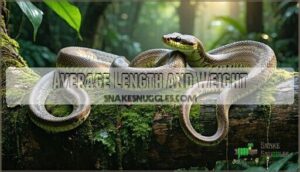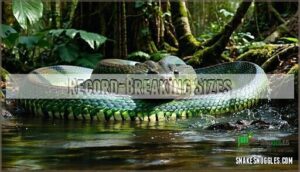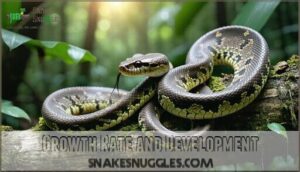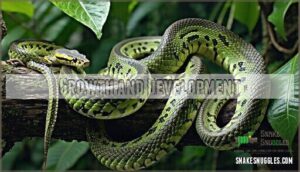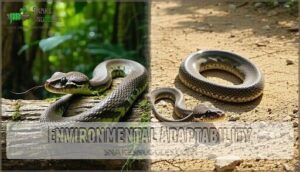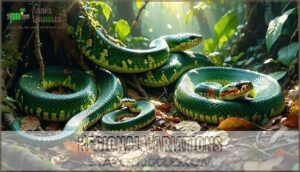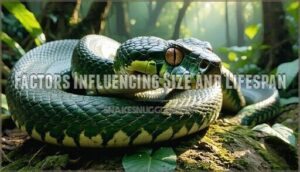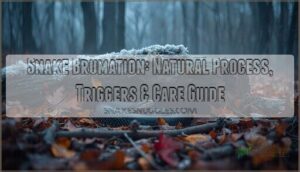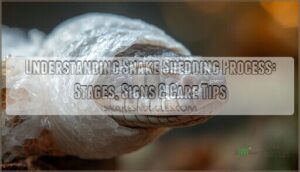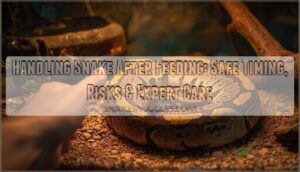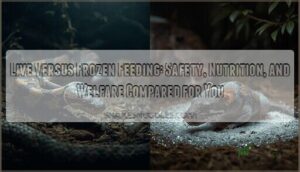This site is supported by our readers. We may earn a commission, at no cost to you, if you purchase through links.
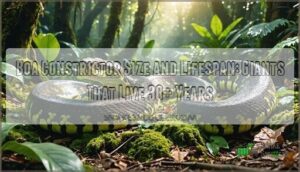
Born at just 2 feet long, they grow continuously throughout their impressive 25-30 year lifespan, with some reaching record lengths of 18 feet.
In captivity, they often live longer than their wild counterparts due to consistent food and veterinary care.
Females typically grow larger than males, and their growth rate depends on factors like diet, temperature, and genetics.
These magnificent constrictors prove that good things come in large packages and stick around for decades.
The secrets behind their remarkable longevity might surprise you.
Table Of Contents
- Key Takeaways
- Boa Constrictor Lifespan
- Boa Constrictor Size
- Growth and Development
- Habitat and Distribution
- Factors Influencing Size and Lifespan
- Frequently Asked Questions (FAQs)
- How big is a full grown boa constrictor?
- Can a boa constrictor live 50 years?
- Are boa snakes aggressive?
- Do boas like being handled?
- How do boa constrictors compare to pythons?
- What are common health problems in boas?
- How much does a boa constrictor cost?
- Do boa constrictors make good pets?
- What are signs of aging in boas?
- Conclusion
Key Takeaways
- You’ll witness dramatic growth as your boa transforms from a 2-foot hatchling into an impressive 6-10 foot adult, with females typically reaching larger sizes than males throughout their development.
- Your boa constrictor can live an exceptional 20-30 years with proper care, and some individuals even reach 40 years under ideal conditions, making them a decades-long commitment.
- You’ll need to understand that growth rate slows dramatically after sexual maturity at 3-4 years, shifting from rapid 18-24 inch annual gains to just 2-4 inches per year in adulthood.
- Your snake’s final size and lifespan depend heavily on genetics, diet quality, environmental conditions, and health care rather than just feeding frequency or quantity.
Boa Constrictor Lifespan
You’ll be amazed to learn that boa constrictors can live an impressive 20-30 years, with some exceptional individuals reaching up to 40 years under ideal conditions.
These remarkable serpents can thrive for decades with exceptional individuals reaching an astounding 40 years of life.
Whether in captivity or the wild, these remarkable serpents maintain surprisingly similar lifespans, though captive boas often outlive their wild counterparts due to consistent care and reduced predation risks.
Lifespan in Captivity
Your captive boa constrictor can live 20-30 years with ideal care, often outliving wild counterparts.
Captive advantages include consistent nutrition, veterinary attention, and protection from predators.
Genetic impact plays a role, but proper husbandry extends lifespan substantially.
Common diseases like respiratory infections are manageable with prompt treatment.
Female boas typically enjoy greater longevity than males in controlled environments.
Maintaining proper temperatures with a quality reptile lamp is also very important.
Lifespan in The Wild
Wild boa constrictor lifespan averages 20-30 years, but you’ll find most don’t reach their full potential.
Most wild boas never see their twentieth birthday despite having decades of potential ahead.
Wild threats like jaguars, caimans, and habitat loss cut their longevity short. Natural diet availability and habitat impact survival rates substantially.
Red-tailed boas face tougher odds, living just 7-12 years on average. Genetic diversity across regions affects their average age and overall resilience in challenging environments.
They’re primarily carnivorous, and diet affects size.
Factors Influencing Longevity
Your snake’s longevity depends on several key factors working together.
Genetic predisposition sets the foundation—some bloodlines naturally live longer.
Diet quality matters enormously; proper nutrition fuels decades of healthy living.
Environmental stressors like temperature fluctuations and poor housing shorten boa constrictor lifespan substantially.
Captivity benefits include consistent health management and veterinary care that wild boas lack, which can contribute to a longer lifespan.
Average Life Expectancy
How long can you expect your boa constrictor to live?
Most boas reach 20-30 years with proper care, though some exceptional individuals hit 40 years.
Wild vs captivity shows minimal difference in boa lifespan, averaging 20-30 years regardless.
Gender differences matter—females typically outlive males due to genetic predisposition.
Environmental impact and ideal conditions substantially influence how long boas live, making boa constrictor age highly dependent on care quality.
Boa Constrictor Size
You’ll be amazed to learn that boa constrictors can grow into impressive giants, with females reaching up to 10 feet long and weighing 60 pounds or more.
These snakes show remarkable size differences between males and females, and their growth patterns change dramatically as they age from rapid-growing youngsters to slowly-developing adults, exhibiting dramatic growth patterns.
Average Length and Weight
You’ll find that adult boa constrictor size varies dramatically between sexes and subspecies.
Sexual dimorphism creates striking weight variation, with females outweighing males substantially.
Here’s what measurement accuracy reveals about average boa size:
- Mature females typically reach 7-10 feet and weigh 22-33 pounds
- Adult males average 6-8 feet with weights of 13-16 pounds
- Growth potential differs by subspecies – dwarf varieties stay under 6 feet
- Boa constrictor length can span from 3-13 feet depending on genetics
- Subspecies size variations mean some populations rarely exceed 5 feet
Adult boa size depends heavily on your snake’s sex and genetic background.
Record-Breaking Sizes
The biggest boas you’ll encounter aren’t always what they seem.
The largest boa on record measured 4.8 meters, though size misconceptions run wild due to anaconda confusion and stretched skins from museum displays.
Weight extremes hit 45 kilograms for exceptional females.
Most adult boa size claims above 5 meters lack solid proof, making full grown boa specimens over 14 feet incredibly rare in documented boa constrictor length records, with size misconceptions and exceptional females being key points of interest.
Growth Rate and Development
Young boas experience explosive growth, reaching 3-4 feet within their first year.
This juvenile growth phase slows dramatically after sexual maturity at 3-4 years.
Understanding your boa’s development helps you provide proper care throughout their journey to adulthood.
Common boas often achieve 18 inches yearly during their initial growth phase.
Here’s what drives boa constrictor growth:
- Feeding Impact – Weekly meals accelerate growth rate more than larger, less frequent feedings
- Environmental Factors – Temperature and humidity directly affect metabolic development
- Growth Dimorphism – Females consistently outpace males in boa constrictor length gains
- Genetics determine maximum boa constrictor weight potential regardless of feeding schedules
Size Variations by Sex
Sexual dimorphism shapes boa constrictor size dramatically. You’ll notice female size typically reaches 7-10 feet, while male length averages 6-8 feet.
Weight differences are striking—females weigh 10-15kg compared to males at 5.9-7.2kg. Males develop longer tail length for reproduction, but females dominate overall boa constrictor length and boa constrictor weight.
Knowing this, remember that diet impacts growth. This size gap appears at sexual maturity around 3-4 years, with growth rate slowing afterward.
Growth and Development
You’ll witness incredible growth patterns as your boa constrictor develops from a tiny hatchling into a massive adult snake.
Understanding these growth phases helps you provide proper care and know what to expect as your serpent companion transforms over the years, which is crucial for its development into a healthy adult.
Rapid Growth Phase
During their first three years, boa constrictors experience remarkable growth spurts that’ll make your head spin.
These juvenile development powerhouses add 18-24 inches annually, transforming from tiny hatchlings into impressive predators.
Their growth rate depends heavily on early diet and environmental impact – proper nutrition fuels this explosive boa constrictor growth phase until they approach sexual maturity around age three or four.
Slow Growth Phase
After maturity around 3-4 years, your boa constrictor growth rate dramatically shifts gears. Post-Maturity Growth becomes minimal as Adult Size Maintenance takes priority.
Growth Slowdown Causes include hormonal changes and energy redirection toward reproduction rather than size increases.
- Growth rate drops from 18-24 inches annually to just 2-4 inches per year
- Ideal Adult Diet focuses on maintaining weight rather than promoting rapid growth
- Lifelong Health depends on avoiding overfeeding during this slower phase
- Mature boas prioritize body condition over additional length
- Size stabilizes around their genetic potential, with minimal annual increases
Factors Influencing Growth
Several key factors control your boa’s growth trajectory.
Genetic potential sets the upper limits, while dietary impact determines whether they’ll reach it.
Environmental factors like temperature and humidity affect metabolism and growth rate.
Sexual dimorphism means females naturally grow larger than males.
Overfeeding won’t create giants—it creates health problems.
Quality nutrition, proper temperatures, and good genetics work together to optimize boa constrictor size development throughout their lifespan.
Maximum Size Potential
Despite exceptional growth potential in captive giants, your full grown boa faces genetic limits that cap maximum length around 14 feet.
Locality influence plays a role—some bloodlines naturally grow larger. However, overfeeding risks create unhealthy weight gains without increasing true size.
Growth rate slows dramatically after maturity, making genuine record-breaking specimens extremely rare. Understanding a boa’s growth stages is essential for responsible care.
Habitat and Distribution
You’ll find boa constrictors thriving across the tropical regions of Central and South America, from Mexico down to Argentina.
These adaptable giants have even established populations in Southern California, proving they can adjust to various climates and terrain types, making them tropical region specialists.
Native Habitats
Stretching across tropical Central America and South America, boa constrictor habitat spans diverse ecosystems where these adaptable serpents thrive.
You’ll find them mastering their environment through strategic choices:
- Rainforest canopies – Dense, humid forests provide perfect hunting grounds
- Open savannas – Grasslands offer abundant prey and basking opportunities
- Abandoned burrows – Underground refuges for temperature regulation
- Riverside areas – Water proximity guarantees prey access and cooling zones
Their regional distribution reflects remarkable environmental flexibility across varied terrains.
Introduced Populations
You’ll find boa constrictors have invaded places far from their South American homeland.
These introduced populations wreak havoc on local ecosystems, with invasive impacts devastating native wildlife through aggressive habitat competition.
Their adaptability is evident as they thrive in diverse locations.
Boa constrictors are also known to be quite adaptable.
| Location | Population Size | Key Impact |
|---|---|---|
| Florida | Growing rapidly | Competes with native snakes |
| Aruba | 10,000+ individuals | 20% decline in endemic lizards |
| Cozumel Island | Established breeding | 60% reduction in small mammals |
| St. Croix | Small but expanding | Threatens native bird species |
Population control efforts struggle against these adaptable giants.
California Boas and other introduced populations show limited genetic diversity due to founder effects, yet they continue expanding their environmental impact across new territories.
Environmental Adaptability
You’ll discover that boa constrictors master environmental adaptability like seasoned travelers.
These serpents thrive across diverse conditions, from steamy rainforests to arid grasslands, making them incredibly resilient survivors.
Their adaptability includes:
- Habitat Diversity – flourishing in tropical forests, savannas, and semi-desert regions
- Climate Tolerance – handling both wet and dry seasons effectively
- Resource Availability – adjusting hunting strategies based on local prey populations
- Urban Adaptation – surviving near human settlements when necessary
- Conservation Challenges – facing habitat loss while maintaining population stability
Regional Variations
Across different regions, you’ll find fascinating local adaptations that showcase genetic divergence in boa constrictor populations.
Subspecies differences create distinct habitat specifics – Central American boas often stay smaller due to island genetics, while South American varieties reach impressive boa constrictor size.
Each habitat shapes lifespan and growth patterns, influencing conservation status across their range.
Factors Influencing Size and Lifespan
Your boa’s final size and lifespan aren’t just luck of the draw—they’re shaped by genetics, diet, habitat quality, and overall health care.
Understanding these four key factors helps you provide the best conditions for your snake to reach its full potential and live those impressive 30+ years.
Genetics Influence
Your boa constrictor’s genetic makeup acts like a blueprint determining its potential size and lifespan.
Genetic variations between subspecies create distinct growth patterns, with some lineages reaching 12-18% larger sizes than others.
Inherited health traits from breeding impact longevity substantially, while mutation effects can either enhance or limit your snake’s development potential.
Diet and Nutrition
What determines your boa’s impressive size and lengthy lifespan? Proper nutrition plays a vital role.
Prey size should match your snake’s girth, while feeding frequency decreases with age. Adult boas need meals every 2-4 weeks.
Meeting nutritional needs without supplementation works best. Understanding appropriate prey options is essential for boa health.
However, obesity risks from overfeeding can dramatically reduce your boa constrictor’s lifespan and limit natural growth patterns.
Habitat Conditions
Your boa constrictor’s habitat conditions directly impact both size and lifespan potential.
Environmental factors like rainforest humidity, burrow availability, and stream proximity create ideal growth conditions. Boa constrictor habitat diversity across regional climates means environmental conditions vary substantially, affecting development rates and longevity outcomes.
Maintaining appropriate humidity levels is essential for boa health.
- Temperature stability promotes consistent metabolic rates and healthy growth patterns
- Adequate shelter options reduce stress and provide security for proper rest cycles
- Water access supports hydration needs and regulates body temperature effectively
Health and Resilience
While proper habitat sets the stage, your boa’s immune system determines whether it’ll reach that 30-year milestone.
Disease resistance varies dramatically between individuals – some boas shrug off respiratory infections while others struggle. Strong genetic health creates the foundation, but stress tolerance and parasite control separate champions from casualties.
Your snake’s injury recovery speed reveals its true resilience potential.
| Health Factor | Strong Boa | Weak Boa |
|---|---|---|
| Disease Resistance | Fights off infections quickly | Frequent respiratory issues |
| Stress Tolerance | Adapts to changes easily | Stops eating when stressed |
| Recovery Speed | Heals from injuries fast | Slow wound healing |
| Parasite Load | Controls mites naturally | Recurring infestations |
Frequently Asked Questions (FAQs)
How big is a full grown boa constrictor?
Full-grown boa constrictors typically reach 6-10 feet long, with females growing larger than males.
You’ll find most adults weigh 10-15 pounds, though exceptional specimens can stretch up to 13 feet and weigh 60 pounds or more.
Can a boa constrictor live 50 years?
While it’s theoretically possible, you’ll rarely see a boa constrictor reach 50 years. Most captive boas live 20-30 years, with exceptional cases documented up to 40 years under ideal care conditions.
Are boa snakes aggressive?
Boa constrictors aren’t naturally aggressive toward humans.
You’ll find they’re typically docile and prefer to retreat rather than attack.
However, they’ll defend themselves if threatened, stressed, or mishandled, using their powerful constriction ability.
Do boas like being handled?
Ever wonder if your scaly friend actually enjoys your touch?
Most boas tolerate gentle handling when properly socialized, but they don’t seek out human contact like mammals do.
They’re more about accepting your presence than craving cuddles. They’re also more inclined to tolerate gentle handling when they have been properly socialized.
How do boa constrictors compare to pythons?
When you’re comparing boas and pythons, you’ll notice key differences in geography, reproduction, and heat detection.
Boas live in the Americas and give birth to live young, while pythons inhabit Africa, Asia, and Australia and lay eggs.
What are common health problems in boas?
You’ll commonly encounter respiratory infections, mites, stuck sheds, and scale rot in your boa. Overfeeding causes obesity and regurgitation, while poor humidity triggers shedding problems and bacterial infections.
How much does a boa constrictor cost?
Need something exotic to command attention? You’ll pay $50-$300 for a baby boa constrictor, with rare morphs reaching $1,000+. Setup costs another $200-$500 for proper housing, heating, and equipment.
Do boa constrictors make good pets?
Boa constrictors can make good pets if you’re prepared for their specific needs.
They require large enclosures, live 20-30 years, and grow 6-10 feet long, demanding experienced handling and significant commitment.
What are signs of aging in boas?
You’ll notice your boa’s eyes becoming cloudy before shedding, decreased appetite, less active behavior, slower movements, and irregular shedding patterns as they age past fifteen years.
Conclusion
Mastering boa constrictor size and lifespan transforms you into a knowledgeable keeper of nature’s most enduring serpents.
You’ve learned these remarkable constrictors reach impressive lengths of 10-18 feet while living 25-30+ years with proper care.
Their growth depends on genetics, diet, and environment, with females typically outgrowing males.
Whether you’re considering ownership or simply appreciating their biology, understanding their decades-long commitment and substantial size requirements guarantees you’re prepared for these magnificent, long-lived reptiles.
- https://darrenhamillreptiles.com/boa-constrictor-husbandry/
- https://www.reddit.com/r/boas/comments/1i72ph3/how_big_do_male_boa_constrictors_get/
- https://www.youtube.com/watch?v=ZmoVy7n4ULk
- https://www.boa-constrictors.com/en/Interesting_facts_about_Boa_constrictor/size_of_a_boa
- https://reptifiles.com/boa-constrictor-care/boa-species-subspecies/

